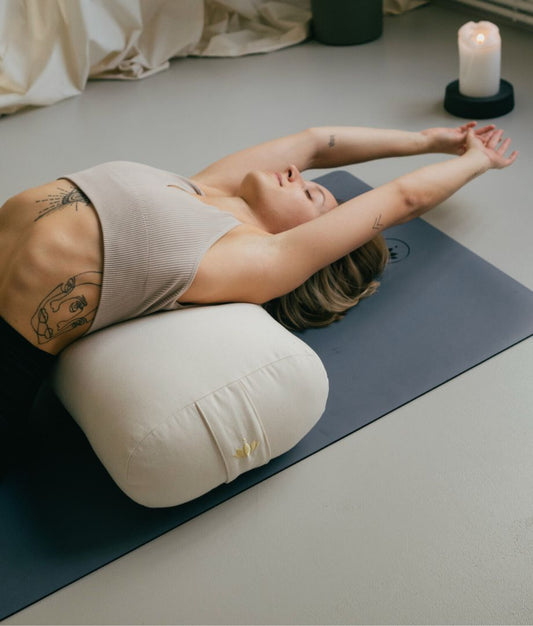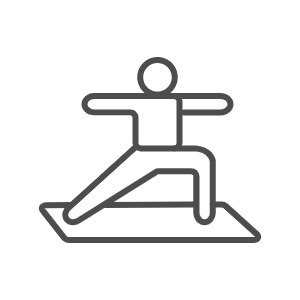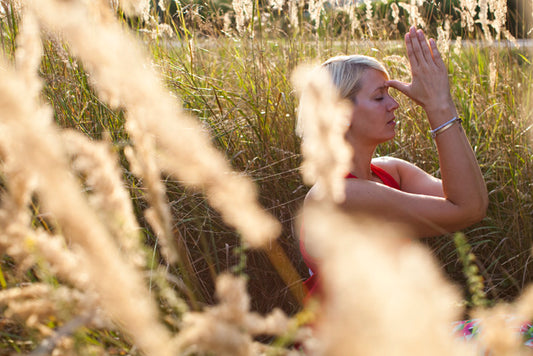
Set-Offers
Save when you buy a set
Shopping cart
Your shopping basket is empty
Yoga

Meditation
Bundles

| Atemtechniken
Close your eyes and take a deep breath! Did you possibly just become conscious of your breathing for the first time today? Most often, our vegetative nervous system takes care of breathing for us, and luckily we don't have to be concerned about it.

In our language, there are common phrases that indicate the importance of the breath: caught your breath, being out of breath, breathing a sigh of relief, taking a breather. Here, the direct connection between breath and emotion is striking. Our emotions, in turn, are closely linked to our mind, which we can train with meditation and yoga. Breathing, therefore, gives us an immediate, powerful tool in our hands.
„The mind is the king of the senses, and the breath is the king of the mind.“
B.K.S. Iyengar
The physiologically most crucial task of breathing is to supply our cells with sufficient oxygen. It becomes apparent when you try not to breathe for two minutes. The average adult inhales and exhales approx. 15 times per minute, and with each inhalation, we take in approx. 0.5 litres of air. Breathing requires different body parts to work together smoothly: The diaphragm provides 60-80 per cent of the muscle power necessary for the breathing process. At the same time, the abdominal and chest muscles are also involved in breathing.
An essential component, however, is, of course, the lungs. Did you know that this organ looks like an upside-down tree and extends from the lower rib arches to the collarbones? These two most essential cavities in our body change during the breathing process: the abdominal and thoracic cavities. Both carry vital organs, and these get an excellent massage with deep, even breathing.
THE BREATH DURING YOGA
Patanjali, the author of the Yoga Sutras, also writes about breathing in Book 2 Sadhana Pada:
2.49 "When the flow of ordinary breath under the condition of good posture expands, that is pranayama, the breathing technique of yoga."
2.50 "Pranayama is practised with mindful awareness of exhalation, inhalation and holding, the area of the body in which the breathing takes place, the length of each phase of the breath and the number of breaths. At the same time, the breath is long and at the same time gently guided."
2.51 "In the fourth type of pranayama, exhalation, inhalation and holding are no longer an issue; they happen by themselves."
Yoga is often described as a form of movement with mindful breathing. It would be better to understand yoga as a form of breathing followed by movements. The basis of any breathwork is breath observation to get to know one's breathing patterns. Most of the time, we unconsciously breathe shallowly, restricted, tense - each in our way. This manifests itself as tension in the body and restlessness in the mind.
On the yoga path, pranayama is essential:: a wide variety of exercises show how one can use breathing to activate and perk up, or calm and relax. In any case, consciously guiding the breath brings us back to the present moment, which is what yoga and meditation are.
Why then is the Social Media Hashtag
#pranayamaeverydamnday not as popular as #yogaeverydamnday?
Ene tägliche Pranayama Praxis erfordert etwas mehr Disziplin als eine Asana-Praxis. In der körperlichen Praxis ist es leichter unser monkey mind (citta) zum Schweigen zu bringen, da wir mit den Positionen beschäftigt sind. Wenn wir „nur“ sitzen und „nur“ atmen, neigt unser Geist dazu gelangweilt und genervt zu sein. Die subtile Arbeit mit der Atemführung ist anfangs also etwas schwieriger, dafür langfristig umso lohnender. Das Sanskrit Wort „Prana“ kann Atmung und Lebensenergie in all seinen Facetten bedeuten, daher sind Atemübungen auch nur eine Art von Pranayama.
Here are a few benefits that come with regular breathing practice:
Deep breathing also releases more of the body's endorphins - if that's not a good reason to stop and take a deep breath more often!

Dharana (eng. concentration) is the ability to stay where you are. Putting the antennas offline, escaping the turmoil of the world and staying on t...
Continue reading
Time for more mindfulness! Today we will introduce you to a very special meditation technique for dealing with stress: Mindfulness Based Stress Red...
Continue reading
There are no comments yet. Be the first to leave a comment!